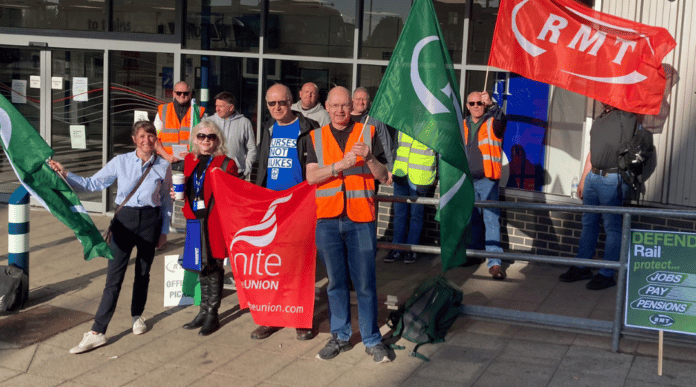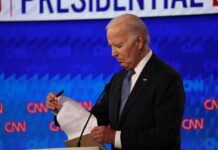Now escalate and coordinate!
Hugh Caffrey, Socialist Alternative (ISA in England, Wales & Scotland)
(This article was first published on 25 June 2022)
As the third day of the national strike by rail-workers organised in the RMT union draws to a close, it is clear that round one has been won by the workers and the union.
Rock solid strike action has demonstrated the power of organised workers when they move into action, with the employers and government left to impotently gnash their teeth and make threatening noises.
Despite an onslaught of propaganda in the media, a majority of the public continue to support the strikes.
This has been helped by the combative stance of the RMT leadership in the media but also because ordinary people are well aware of the cost of living crisis, the profit-driven threat to jobs across the economy and the utter disaster that rail privatisation has been for everyone except the profiteering bosses and shareholders. So what happens next?
The employers as a whole and the government have no intention of backing down. This is a coordinated and deliberate assault which has been planned for years in Network Rail and goes to the heart of the operating model for the Train Operating Companies, who want less staff on lower wages.
The bosses and Tories can be beaten but it will take further industrial action to make them back off. This is at a time when other groups of workers are looking to enter the fray, first at Royal Mail and British Airways, and then in the autumn among education workers, civil servants and others, with numerous additional local disputes among private and public sector workers.
These disputes all spring from the same source: the fundamental crisis of the British and world economy.
Escalate the strikes
Solidarity among the RMT membership has delivered solid strike action this week. The next round of rail strikes needs to be worked out in dialogue with the base of the union, to decide the most effective plan of action.
The dates should be decided by the membership, but clearly as the Tory government escalates its anti-union threats then the union needs to escalate the response with a bigger number of strike days. Sections of the RMT membership on the railways which weren’t on strike this time need to be brought into the dispute, whether by re-balloting to hit thresholds or on the basis of their own distinct demands and concerns.
The employers are clearly fearful of this, hence the 7.1% pay offer on Merseyrail (as compared with the 2–3% being offered to national rail workers). The union should seize on this fear to widen the dispute and win more. Aslef and the TSSA need to ballot their own members over similar issues and join the dispute before they are used against it.
Solidarity with the rail dispute is essential. The Tory threat to lift the (ineffective) legal restrictions on employers using agency workers to do the work of strikers shows the limits of ‘progressive’ laws which rely on the goodwill of judges and politicians.
Whether or not the employers can break strikes by bussing in scabs depends ultimately on the strength and power of the strike. Any attempt to use agency scabs should be met with picket lines that prevent the scabs going in, backed up by mass solidarity demonstrations mobilised by the local trade union movement.
The agency bosses seem nervous of the repercussions of being used as a scab army and, if they do assist the Tories, this can be built on with protests outside their outlets demanding they withdraw the scabs and appealing to agency workers not to act as strike-breakers.
The P&O dispute showed some of the dangers and the potential around this, with scab security guards used as a mob of thugs by the bosses, but also agency workers walking off the job when they found out what they were being used to do.
Mobilise solidarity and public support
The accusations that rail workers are preventing nurses from helping the sick or teachers from educating the young need to be rebutted head on with strong statements from the public sector unions about why they support the rail strikes, and a campaign among their own members to explain why all workers should support the rail strikes, connecting this to the similar issues faced by health workers, education workers and so on.
Public support remains high but needs to be tapped into. We need to see large local demonstrations called by the RMT and the local trade union movement, mobilising rail workers, postal workers and others.
The RMT’s policies of ‘fair fares’ and rail renationalisation need to be brought to the fore. The role of a public, well-funded and affordable rail network in addressing the worsening climate crisis should also be made clear.
Calling local protest marches with leaflets that can be given to the public on the picket lines can tap into the wave of wider support and start to mobilise the wider trade union movement. The CWU should back this and add its own demand for renationalisation of Royal Mail to the slogans for demonstrations.
It’s not hard to imagine the huge support there would be for well-organised union-led marches in every town and city, demanding ‘Renationalise rail and mail! Defend jobs! All workers need a pay rise!’
The TUC national demonstration on 18 June showed a fraction of the potential for this with 50,000+ people attending. Now the unions on strike nationally and locally need to pick up the baton of mobilising in the streets.
Time for coordinated strike action
Coordination goes beyond demonstrations to coordinating strike ballots and strike dates. At a national leadership level the RMT and CWU need to coordinate their strike dates to strike on at least some of the same dates for maximum effect.
At a local level, RMT activists on the rail and CWU activists on the mail should make contact and have the same discussion to take back into their unions to make sure the battles are brought together. Where there are local disputes, often involving Unite members, these can be brought into the same discussions.
Numerous unions are talking about industrial action in the autumn: the NEU in schools, PCS in the civil service, and Unison’s general secretary has gone from attacking other unions for being prepared to strike to boasting that her union will be “strike ready”.
Coordinating ballot timetables between all these unions, and the RMT if or when it has to reballot, is one of the most effective ways of showing to members of all the unions that the movement is serious enough and big enough to take on and defeat the government and the employers. This in turn will help to reach the anti-democratic turnout and support thresholds required by the anti-union laws.
Preparation for this starts now. Not just the technical aspects, but directing support to the workplaces and workplace activists, involving the widest number of members in actively building support for strike ballots. This should be around clear demands, and direct coordination by workplace reps across the base of the unions especially in multi-union workplaces (e.g. NEU and Unison in schools, Unison and Unite in hospitals, and so on) to jointly campaign for the maximum turnout of all members, regardless of which union they’re in.
The Tories are looking to the autumn filled with fear. This is why they are threatening to bring in ‘minimum service’ legislation, which basically means a large proportion of workers who vote to strike are then legally banned from going on strike.
This can be made unworkable by mass industrial action, official and also unofficial where necessary, backed up by demonstrations and protests to defend the picket lines of any union threatened with a scab’s charter.
Even more legal assaults on the unions do raise the question of workers’ political organisation. As welcome as the support of a smattering of Labour MPs may be, there is no chance at all that the Labour party will be a useful tool for workers to organise through to build their struggles, demand public ownership or enforce the repeal of all the anti-trade union laws.
Establishing local umbrella campaigns such as “[Town/city name] needs a pay rise,” or local conferences of resistance or cost-of-living assemblies, can start creating the political space for workers and campaigns to come together, reach out to community organisations and the mass of the working class, and discuss the wider political questions of how the cost-of-living crisis can be overcome.
On the basis of this, steps towards a new mass left party of struggle could be taken, a party of a completely different type, not mainly focussed on elections but one which is an organisation by, of and for working people and through which they can get politically organised.
Socialist Alternative argues that to achieve a real solution, such a party would require a socialist programme, in opposition to the crisis-ridden capitalist system.
Round one of the rail strikes belongs to the rail-workers, and the wider working-class. The Tories will come back hard while the economy continues to slide towards deeper crisis and recession.
Round two will be won by solidarity, coordination and escalation to knock out the Tories and take the battle to the bosses and their system as a whole.




